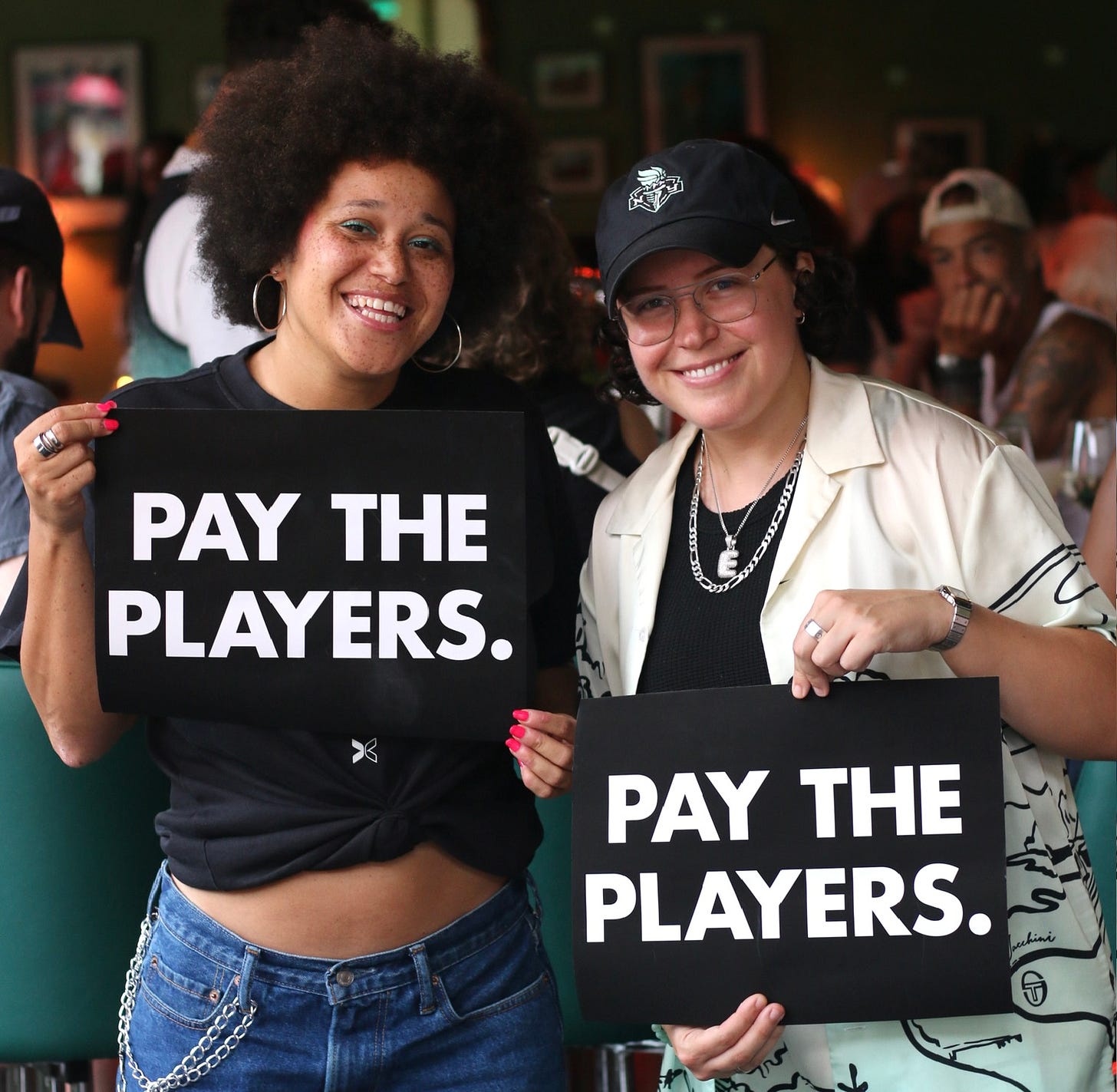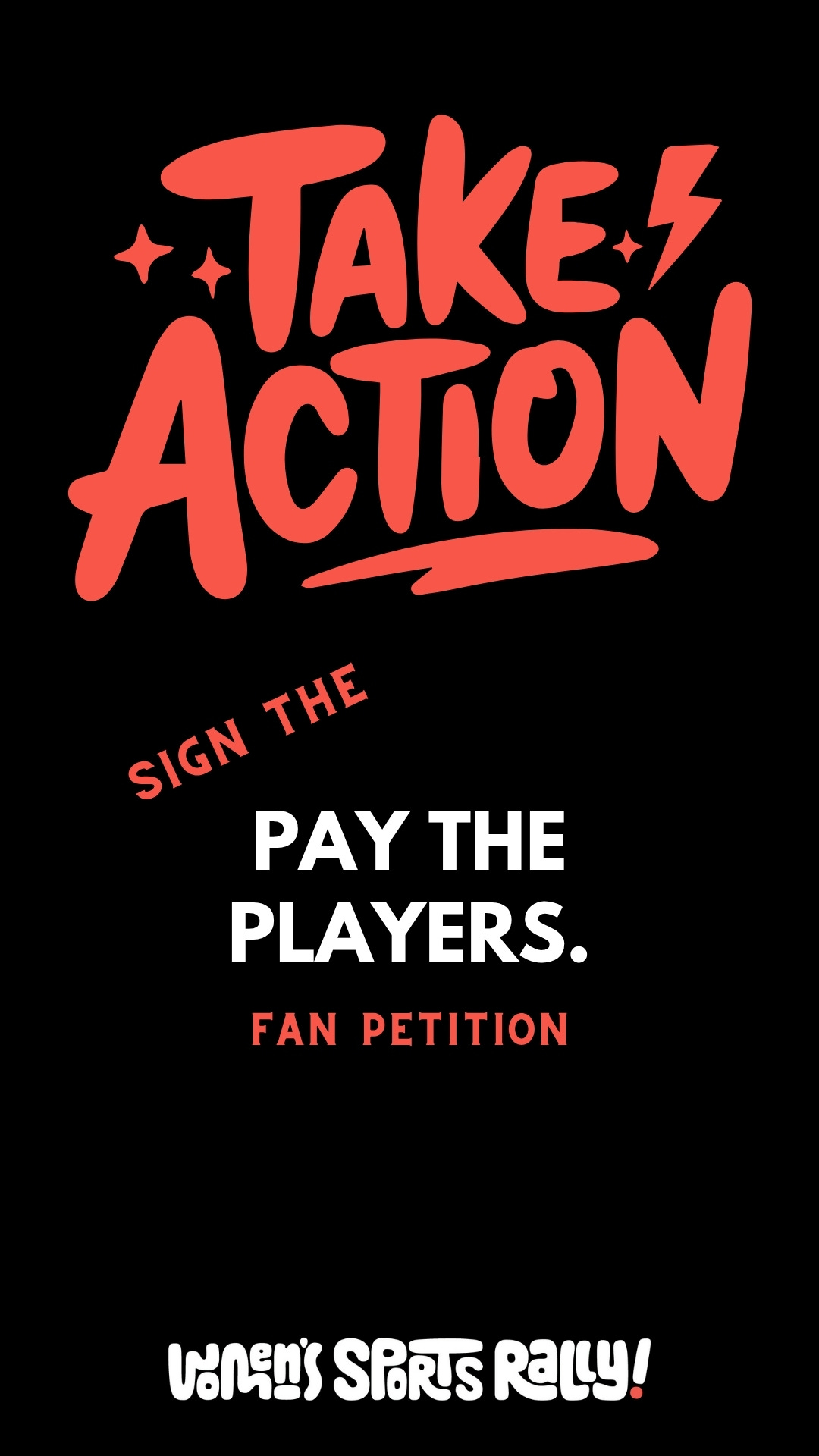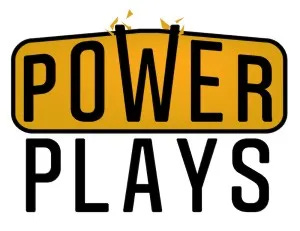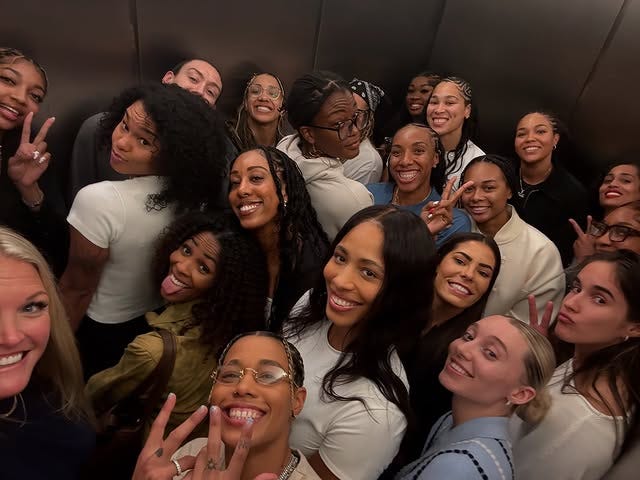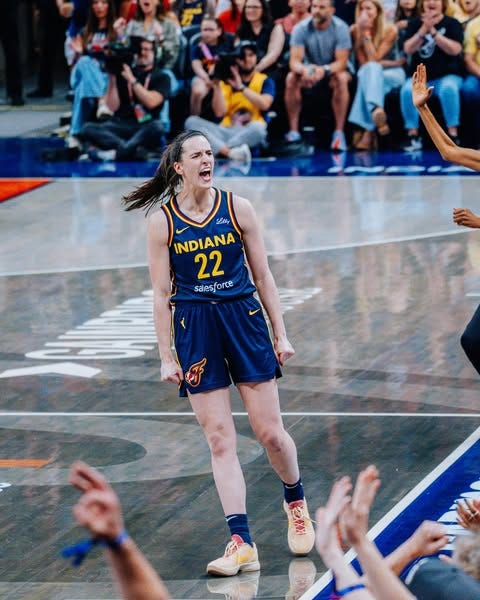The facts and fiction fueling the WNBA's CBA fight
This Labor Day, let's dive into one of the most consequential labor fights in women's sports history.
This edition of Power Plays is sponsored by the Working Families Party, a progressive political party in the United States that bills itself as “the party of the multiracial working class, fighting for our freedoms and to build a nation that cares for all of us.”
WFP has teamed up with Women’s Sports Rally to launch a fan petition urging the WNBA to pay players what they are owed.
“Now, it’s time for the WNBA to meet this moment,” the petition reads. “The league cannot sustain growth without its players. The WNBA’s future and its integrity depends on a contract that honors those who make it what it is: the players.”
Click here to sign the petition and help them reach their goal of 800 signatures by Friday!
Hi, friends. Happy Labor Day! This holiday isn’t just about the unofficial end to summer, or U.S. Open tennis, or cookouts, or mattress sales. It’s a time to celebrate labor movements, unions, and the contributions that workers have made to our society.
And so it is fitting that today we are taking a deep dive into the current labor strife in the WNBA.
Before we get into the nitty gritty, let’s briefly recap how we got here: The WNBA Players Association (WNBPA) opted out of their current collective bargaining agreement (CBA) at the end of last season. The deadline for a new deal is October 31, 2025, which two months away. The players have repeatedly stressed that they are looking for a “transformational” deal, and WNBA commissioner Cathy Engelbert has echoed that language. But it seems the two sides might have different definitions of that word.
In July in Indianapolis, on the Thursday of All-Star weekend, upwards of 40 players — a pretty unprecedented number — attended a bargaining session with the league; they all left that meeting feeling frustrated at best, and down-right disrespected at worst.
Less than 48 hours later, the players took the court before the All-Star game wearing t-shirts that said, “Pay us what you owe us.” By the time the game tipped off, the message had gone viral online.
The virality, it seems, hasn’t sped up the negotiating process. Annie Costabile of Front Office Sports reported this week that its unlikely there will be a deal by the October 31 deadline. The WNBPA said in a statement that “the league’s lack of urgency leaves players wondering if it is focused on making this work or just running out the clock.”
(In response to Jackson’s statement, a WNBA spokesperson said that “our number one priority is to get a new collective bargaining agreement completed that addresses the players’ priorities while also supporting the long-term growth and success of the league and teams,” adding that the WNBA has been meeting with the WNBPA “throughout the summer” and that “additional sessions” are already on the calendar for the rest of the season.)
But the virality has spurred a lot of takes. Unfortunately, so, so many of those takes are based on information that is misreported, misconstrued, or just plain missing the point.
So, that’s where we come in. The goal is to go beyond the click-bait headlines, filter out the bullshit, and focus in on the reality of what I believe could be one of the most paradigm-shifting contract negotiations in women’s sports history. In the past, labor fights in women’s sports have been about sneaking as many crumbs as possible. This one is about securing a significant slice of an ever-growing pie.
Here’s a look at what the players are asking for; how profitability, revenue sharing, and Caitlin Clark impact negotiations; and what comes next if the October 31 deadline comes and goes without a deal.
It involves a lot of numbers, but stick with me.
You ready? Let’s do this.
Myth: The WNBA players are asking for pay equality with the NBA.
Reality: This one is absolutely FALSE. The players are not asking for anywhere close to equal pay with NBA players.
Still, I think it helps to sit down and really look at the numbers both of these leagues are dealing with.
This season in the WNBA, the minimum salary is $66,079, the max salary is $249,244, and the salary cap for each team is about $1.51 million.
This upcoming NBA season, the minimum salary for players with no experience, is $1,272,870. The maximum salary is $54,126,450. And the salary cap is $154.647 million.
That means that right now, the NBA’s minimum salary is 18.26 times bigger than the WNBA’s minimum salary; the NBA’s max salary is 216.2 times bigger than the WNBA’s max salary; and the NBA’s salary cap is 101.45 times bigger than the WNBA’s salary cap.
So, we’re not talking about a wage gap. We’re talking about a wage abyss.
And yet, I promise, nobody in their right mind is suggesting that WNBA wages jump 10,014.5% overnight! These women are not dumb. WNBA players are well aware the WNBA’s economics are much different than the NBA’s.
According to CNBC, the average NBA team is worth $4.66 billion. The most valuable team, the Los Angeles Lakers, are worth $10 billion and the least valuable team, the Memphis Grizzlies are worth $3.2 billion. The NBA just signed a media rights deal worth $76 billion over 11 years, or $6.9 billion a year. The league collectively made about $13 billion in revenue last year.
In the WNBA, Sportico reports that the average team valuation is $269 million. The most valuable team, the Golden State Valkyries, are worth $500 million, and the least valuable team, the Atlanta Dream, are worth $165 million. The WNBA’s new media deal is worth about $200 million per year, or $2.2 billion overall.
So no, equality isn’t the goal. But equity is.
In the NBA and many other major sports leagues, players receive 50% of the league’s revenue. In the WNBA, the players currently only get about 9.3% of league revenue. *That* is the chasm they’d like to see close.
Of course, that brings us to our next issue …
Myth: The WNBA is not a profitable business
Reality: This is technically true, and I’m not going to pretend otherwise. But it won’t be true for much longer.
To understand this, we have to talk about the structure of the league.
For most of the WNBA’s existence, the NBA has owned 50% of the league, meaning NBA owners split 50% and WNBA owners split the other 50%.
But in 2021, the WNBA raised $75 million of capital at a $400 million valuation, which gave that group of investors an equity share of 16% — half from the NBA’s stake and the other half from the WNBA’s stake.
So now, we’ve got the NBA at 42%, the WNBA at 42%, and the newcomers at 16%.
But even that doesn’t paint a full picture, because these categories are not at all mutually exclusive. Today, six of the 13 WNBA teams are owned by their NBA counterparts. Four of the five expansion teams coming in the next four years are run by NBA owners, too. That means some NBA owners have league equity coming from their NBA and WNBA sides. ALSO, a few NBA owners were part of the $75 million fundraising round, meaning they are triple-dipping in equity shares.
Why does this matter? Well, first of all, it shows how much control the NBA still has over the league. And it also demonstrates that when it comes to WNBA accounting, absolutely nothing is simple and straightforward. There are a lot of different ways to finagle numbers, a lot of different agendas to take into account, and next to no transparency and accountability to help us sort through it.
But let’s take the numbers we’re given at face value. Last fall, the New York Post reported that the WNBA lost $40 million in 2024, that the league hadn’t had a profitable season since it launched in 1996, and that NBA owners were getting antsy to get their money back.
I’m not going to sugar coat it: That’s obviously not ideal! But context matters.
The WNBA has not lost $40 million a year every year of its existence; previously, NBA commissioner Adam Silver has said that the NBA loses about $10-12 million a year on the WNBA. (Last year’s number was bigger in large part because the WNBA started offering chartered flights to its players, which reportedly cost around $25 million.) In a recent paper, economist David Berri, a professor of economics at Utah University, calculates that including inflation, the NBA has lost around $440 million on the WNBA since its inception.
But starting next season, that will change. Currently, the WNBA has an annual TV deal worth around $60 million. But next year, game-changing new TV deals kicks in. We already know the primary TV deal is worth $200 million per year, which is the WNBA’s portion of the NBA media rights deal, and the WNBA expects to bring in at least $50 million a year extra from separate television deals with companies such as ION and CBS Sports.
Let’s presume that this year the WNBA lost $40 million like it did last year. That means just counting the TV deal alone, a $40 million loss could turn into a $150 million profit.
Of course, one year of profitability does not automatically erase 29 straight years of losses. And it’s understandable that NBA owners want their money back.
But it’s important to clarify that the $440 million loss estimate is split amongst 30 NBA owners over an almost 30-year period. Also, most NBA owners are billionaires, and every NBA team is worth at least $3.2 billion. Nobody is hurting here.
And while I am not sure the exact mechanics involved in getting the NBA owners remunerated, I am positive that pathways should be available over the next few years.
We already established that the new TV deal should put the WNBA in the green next season, and that calculation doesn’t even account for the increased revenue generated by the uptick in attendance, sponsorship, and merchandise sales. Revenue is rapidly rising.
Additionally, WNBA team valuations are absolutely exploding, going from about $2 million five years ago to an average of $269 million today. And with six expansion teams joining the league from 2025-2030, the league is bringing in $925 million in expansion fees. Recently, the owners of the Philadelphia 76ers, Detroit Pistons, and Cleveland Cavaliers all paid $250 million in expansion fees to start WNBA teams. They would not be doing that if the WNBA was the black hole of financial ruin that the anonymous NBA owners complaining to the Post would have you believe.
There is real value there, and it’s more than reasonable for the players generating that value to want to be compensated accordingly.
Which, again, brings us back to revenue sharing.
Myth: There is no revenue-sharing agreement in the current CBA
Reality: Revenue-sharing has been included in the WNBA CBA dating back to 2003. The problem is, it has never been triggered.
The WNBPA got a revenue-sharing clause in their second-ever CBA. But these agreements have always been incremental, meaning things like the salary cap and bonuses are fixed unless certain revenue targets are surpassed. Those targets have always been out of reach.
Prior to 2020, the revenue-sharing targets were tied to ticket sales. But during the last CBA negotiations, the WNBPA decided to change its strategy.
“It was never going to be triggered because we are not seeing at the team level the type of staff and infrastructure and salesforce that is needed,” WNBPA executive director Terri Jackson told me a few years ago.
Instead, Jackson and the WNBPA were fought to get the revenue-sharing targets tied to overall league revenue. This felt like a win at the time, because commissioner Cathy Engelbert was bringing in so many new sponsors.
Jacob Mox has done great work on the revenue-sharing agreement in the current CBA over at Her Hoop Stats and The IX Basketball. Here he describes how the annual targets are calculated:
We can’t know for sure what the exact revenue targets are each season, but the formula is quite straightforward: The annual league revenue for 2019, which is unknown, is compounded by 20% each year for the annual target. As a hypothetical, this means if league revenue in 2019 was $50 million, then the annual target in 2020 would be 20% higher at $60 million. The annual target in 2021 would be another 20% from the previous year, making it $72 million.
Since we know that league revenue doubled over the course of this CBA, this seems like a good deal for the players. But there is a catch: The targets are actually cumulative.
Here’s Mox again:
Going back to 2020, all revenues are added together to find the cumulative revenue, and all revenue targets are added together to find the cumulative revenue target.
In the previous example, the annual target in 2022 would be $86.4 million using the $50 million in 2019 assumption. As a result, the cumulative revenue target for 2022 would be $218.4 million.
Cumulative Revenue for 2022 = 2020 Revenue + 2021 Revenue + 2022 Revenue
Cumulative Revenue Target for 2022 = 2020 Target + 2021 Target + 2022 Target
Because of the COVID-19 pandemic that forced the 2020 season into a fan-less bubble, the revenue in 2020 was so much lower than the pre-established target, which was based on 2019 revenue, that reaching the revenue targets for the rest of the CBA was next to impossible.
So if this CBA continues to utilize incremental revenue sharing rather than basing their salary cap fully on revenue, the WNBPA needs to make sure it establishes reachable revenue-sharing targets.
Then there’s the matter of the revenue-sharing percentage.
As we already mentioned, WNBA players earn about 9% of league revenue, while players in other leagues, like the NFL, NHL, and NBA, earn about 50%. Now, operating costs are significant and its important that the league and teams are still able to invest meaningfully in that area, so I do not expect WNBA players to get close to 50% in this CBA;
But we do know players are looking to share in year-over-year revenue growth, so that they can more directly benefit from the league’s surging popularity. In the NBA, the salary cap each year is tied directly to revenue, meaning it can grow as the league grows. This season, the NBA salary cap will be 10% higher than it was last year. The WNBA salary cap, meanwhile, is fixed at a 3% increase each year.
A big increase in the fixed salary cap will go a long way towards bridging the equity gap. But fair revenue-sharing targets that allow the salary cap to grow in real time could be revolutionary.
Myth: Caitlin Clark is the only reason for the increase in WNBA profitability.
Reality: Caitlin Clark is absurdly important to the WNBA. But she doesn’t exist in a vacuum.
I want to be very clear here: Caitlin Clark’s unprecedented popularity and magnetic talent has supercharged the WNBA.
But people implying that the only reason anyone is watching the WNBA is because of Clark, and that if she can’t play it all falls apart, are wrong.
The WNBA was on the upswing before she arrived. Per Bloomberg, league revenue doubled between 2019 and 2023. Clark wasn’t drafted until 2024.
In fact, The Athletic reported that the new WNBA television deal was actually negotiated before the 2024 WNBA season began, meaning before Caitlin Clark even played a single game in the league. I’m not saying her presence was a non-factor in negotiation; her arrival into the WNBA was highly anticipated. But nobody truly knew what Caitlin Clark’s impact would be on attendance and ratings until the 2024 season began.
And again, her impact has been massive. The 2024 WNBA Draft, which featured Clark and her college rival, Angel Reese, drew over 2.5 million viewers, making it by far the most-watched WNBA Draft of all time. In the first two weeks of the 2024 season, six networks had their most-watched WNBA game in history; five of those records came in Indiana Fever games featuring Clark.
The trend continued all season; the Fever’s first-round playoff games were the highest-rated games of the year, peaking at 2.5 million viewers. By contrast, the finals “only” averaged 1.54 million viewers. I put “only” in quotation marks because 1.54 million is still a strong number — in fact, it’s a 115% viewership increase over the 2023 WNBA Finals.
That’s a pattern that keeps being reinforced — with Clark, ratings and attendance skyrocket. But even without Clark, the numbers paint a picture of a growing, thriving league.
This season, Front Office Sports reports that while Fever games are by far the most-viewed WNBA games on television, non-Fever games are averaging 549,000 viewers, a 37% increase over 2024.
Clark unfortunately has been injured for all but 13 games so far this season, and was notably forced to be sidelined during All-Star weekend. Many headlines seized on the fact that ratings were down 36% from the 2024 game, when Clark played, teaming up with Angel Reese against Team USA ahead of the Olympics. However, the 2025 All-Star game still drew 2.19 million viewers, a 52% increase over any other All-Star game in league history.
Attendance tells a similar story. The WNBA broke its all-time attendance record for a season with two and a half weeks of the regular season remaining. Through 226 games in 2025, WNBA games drew 2,501,609 fans. The previous milestone was set in 2002 over 256 games. In 2002, the WNBA had 16 teams. This year the league has 13.
Across the Timeline calculates that this season, the league averages 10,930 fans per game, which is just edging out the previous record in 1998 of 10,869 fans per game. This is particularly impressive given that six teams play in arenas that are smaller —drastically so, in some cases — than said average attendance: The Atlanta Dream (3,265); Chicago Sky (10,387); Connecticut Sun (8,910); Washington Mystics (4,200); Dallas Wings (6,251); and Las Vegas Aces (10,509).
Yes, the Caitlin Clark effect helps in that regard. The year before Clark, attendance for the Fever averaged 4,066.80. Their lowest-attended home game in the last two years had 15,022 fans. But they’re not the only team drawing big crowds.
The Golden State Valkyries have sold out every home game this season with 18,064 fans per game. The Fever are just behind that, averaging 16,665 fans per game. The New York Liberty are averaging 16,265 fans; with the Los Angeles Sparks at 12,317; Seattle Storm at 11,730; Phoenix Mercury at 11,122; and Aces at 10,871.
Six teams other than the Valkyries are averaging the most fans in franchise history — the Sky (9,179), Sun (8,730), Wings (7,320), Sparks, Storm, and Liberty. Of course it helps that when Clark and the Fever come to town, teams are almost guaranteed to have a sell-out crowd, and many teams move those games to bigger arenas to accommodate the interest. But the Storm, Sky, Sun, and Wings have all set attendance records even if you remove the Fever games from the calculations.
So yes, the Caitlin Clark effect is real. But it is accentuating a strong product, not propping it up.
Myth: If there is no deal by October 31, the players are going on strike.
Reality: It is much more likely that the league and players agree a deadline extension.
As I mentioned up top, it is increasingly unlikely that a deal will be reached by the October 31 deadline. That isn’t surprising. It is difficult to get bargaining done in-season, and the WNBA playoffs will stretch well into October. (October 19 is the last-possible day for the WNBA Finals.)
That doesn’t mean a strike is inevitable, though! WNBA CBA negotiations have never resulted in a lockout or games missed, though in 2003 the draft and preseason were postponed for a few days until a deal was reached. The players and owners can agree on a deadline extension that would allow the talks to continue without a work stoppage. There is recent precedent for this — in 2019, a few days before the October 31 deadline, a 60-day extension was announced, and the new CBA was ratified in January.
But this year there is more urgency to get a deal done in a timely manner because two expansion teams are set to debut in 2026 — the Portland Fire and Toronto Tempo. Expansion and free agency rules are dictated by the CBA, so it would be next to impossible to hold an expansion draft before a new CBA is negotiated. (Last year, the expansion draft for the Golden State Valkyries was held on December 7.)
And, of course, the spotlight and the scrutiny that accompanies it heighten the sense of urgency, too.
There are a lot of issues left to figure out. Yes, players want larger salary caps and a greater share of the revenue. But they also want a soft salary cap, expanded rosters, a less-grueling schedule, standardized practice facility and training conditions across the league, and increased parental and retirement benefits, among other things.
Owners, meanwhile, really want prioritization protections — guarantees that players will not let commitments with other leagues or their national team interfere with their allegiance to their WNBA teams.
The WNBA has proved that it can survive. With this new CBA it needs to set itself up to thrive.
Up next: Later this week, we’ll look back at past WNBA CBA negotiations and examine how we got to this point.
This edition of Power Plays is sponsored by the Working Families Party, a progressive political party in the United States that bills itself as “the party of the multiracial working class, fighting for our freedoms and to build a nation that cares for all of us.”
WFP has teamed up with Women’s Sports Rally to launch a fan petition urging the WNBA to pay players what they are owed.
“Now, it’s time for the WNBA to meet this moment,” the petition reads. “The league cannot sustain growth without its players. The WNBA’s future and its integrity depends on a contract that honors those who make it what it is: the players.”
Click here to sign the petition and help them reach their goal of 800 signatures by Friday!
UPDATE (9/3): This newsletter has been edited to add a statement by the WNBA and to remove language stating that the WNBA’s new media deal is a “portion” of the NBA’s new media deal.


